Pet Mice Breed & Varieties: What Type of Mice Are Your Pets?

When you have a pet, it’s natural to be curious about it. What’s the name for its colour? What’s that type of marking called? Why is its fur smooth or wavy?
All these questions can be answered by identifying the variety your mouse belongs to. Fancy mice all belong to one species – Mus musculus, which we also know as the common house mouse. However, they have been being bred as pets for nearly 200 years, which means they now look quite different to their wild cousins, with varying body and ear sizes. Unlike rats, mice have tails and ears the same colour as their coat, but those coats can come in a huge range of colours. These have lots of different names depending on where you live. We’ve tried to give the most common ones below.
This article was co-authored by Beri Instone, rodent wrangler extrordinaire.
Agouti mice

Agouti is the natural wild colour, defined as being “a brown color made of hairs banded (or ticked) in black, grey, brown and orange”. Agouti mice can come in a range of shades depending on how much black there is on the hairs, but they are usually a warm chestnut. They have black eyes.
Like in rats, agouti can also form a base for other colours and varieties, identifiable by having ticked hairs (some people call them ticked varieties for this reason). Common agouti-based varieties include:
Blue agouti – slate blue colour with black ticking. Eyes black.
Cinnamon – coppery brown fur. They are very similar to a normal agouti mouse except the ticking on hair is brown rather than black. They have black eyes.
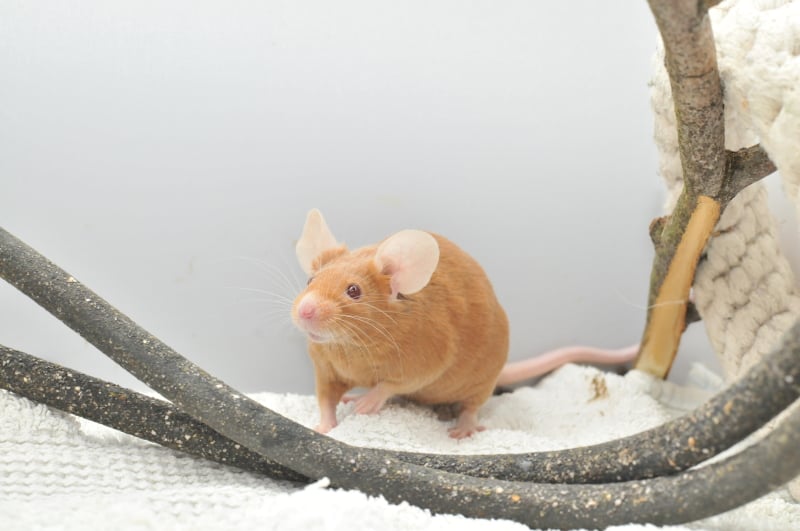
Argente – this is officially agouti modified by the gene for pink-eyes. That gives the darker parts of the hair soft orange tones, making the fur look yellowy with silver ticking. Some have a blueish undercoat, but some argentes don’t have this and look very orange. Looking for the ticking helps tell whether your mouse is an argente or a red.
Self mice
These are mice that don’t have ticking in their fur – their hairs are each a solid colour. Common self varieties include:
Black – goth mice! Black fur with black eyes. Mice don’t rust and fade the way black rats do, and so stay incredibly dark.
Chocolate – brown fur, usually milk chocolate in colour although the exact shade can vary. They have black eyes.
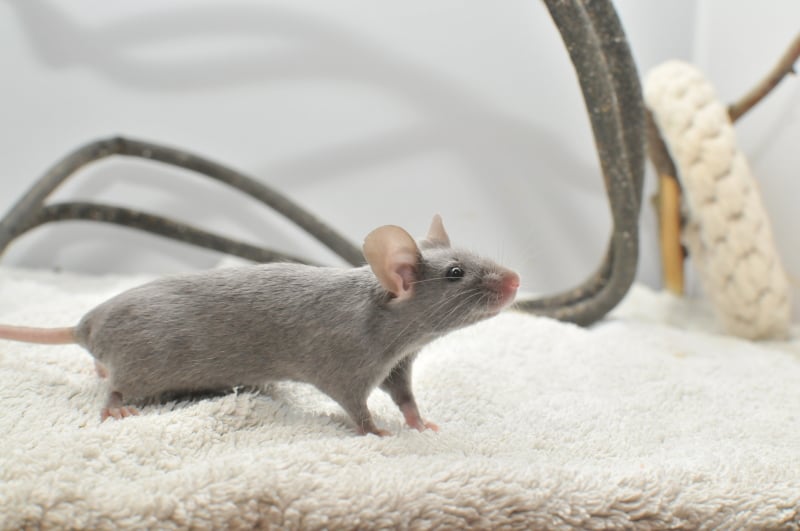
Blue – this variety is called blue but most people would call the colour grey. The fur is a warm dark slate colour (not pale or cold) and the mice have black eyes.

Lilac (Eur), Dove (US) – time for come confusing names! Technically this is a chocolate mouse with the colour modified by the gene for blue. The fur is a warm pale pinky-grey that goes browner as they age. The eyes are black.
Dove (Eur), Lilac (US) – confusing names part 2! These are genetically black mice whose colour has been modified by the gene for pink eyes. That gives them fur of a greyish warm magnolia (or a warm magnolia grey).
White – white fur with black or red eyes. The proper names for these varieties depend on the eye colour, but white covers the essentials!
Tan mice
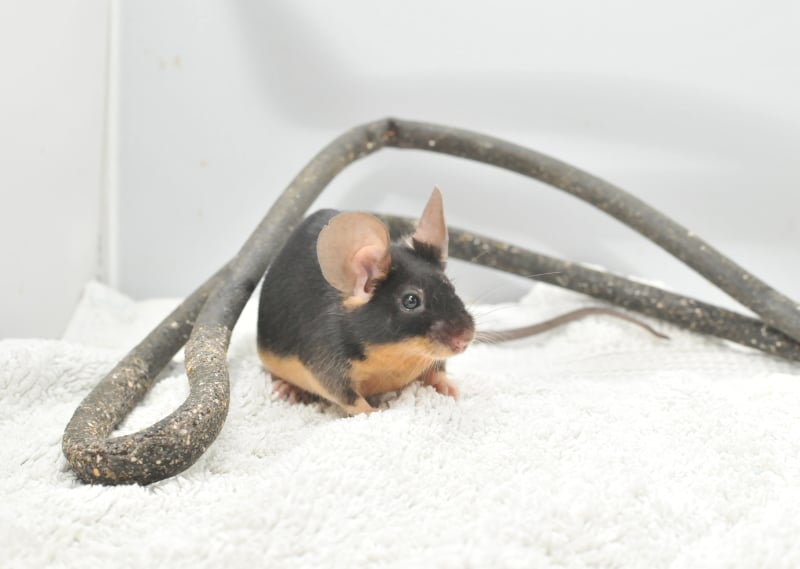
These mice can have any of the above self or agouti ‘top’ colours, but also have a bright orange tummy! The difference is most obvious on dark-coloured mice (e.g. black tan), but they can come in any colour. In marked tan mice, the orange only covers the non-white parts of the tummy. This is one of those colours that only occurs in mice and which some rat breeders are rather jealous of.
Pointed mice
Imagine a mouse wearing a magnolia (Siamese) or whiteish (Himalayan) onesie, but with holes cut out at the nose, hands, legs, ears, and bum allowing their ‘real’ colour can show through. That’s a pointed mouse, although most have a gradual colour change rather than a sharp line. The coloured parts (points) are clearest when the underlying colour is a dark self like black (seal pointed) or blue.
Patchwork coloured mice
Brindle – this is the same principle as a brindle dog, and occurs in any colour. There are various different brindles around the world and some have sex-linked health issues, so it is a good idea to research your local types before adopting.
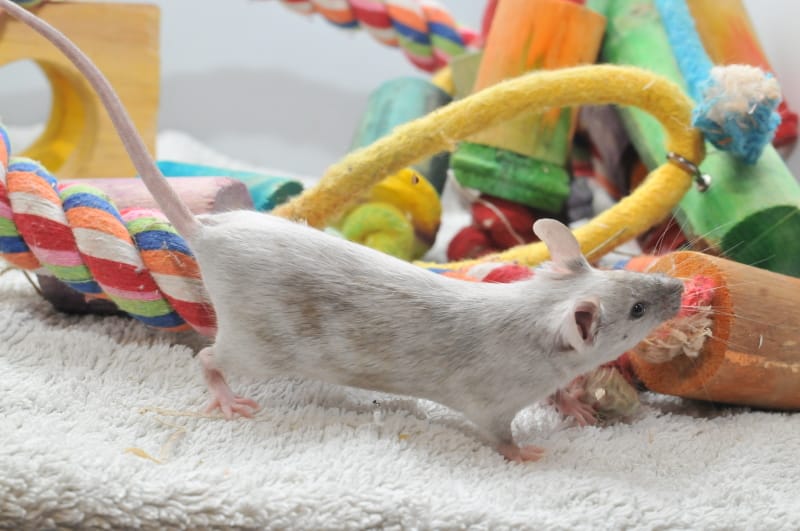
Splashed – these mice have coloured blotches of two shades on a washed-out background fur colour. Sometimes the blotches can be regular with clear edges, sometimes the colours blur into the background more. These mice can also have points.
Merle/roan – a similar colouring to merle dogs with two-tone splodgy patches over the body. There’s a big range in this variety from from big splodgy dark patches (merle) to fur that is mostly ticked with silver (roan).
Marked mice
These mice have areas of white in the coat, and can occur on top of any colour variety. The markings can be so large that they look like white mice with coloured patches. Common markings include:
Dutch – white, with a coloured blob around each ear and eye, and coloured shorts.
Banded – a coloured mouse with a white belt
Rump white – colour on most of the body, white from the hips down
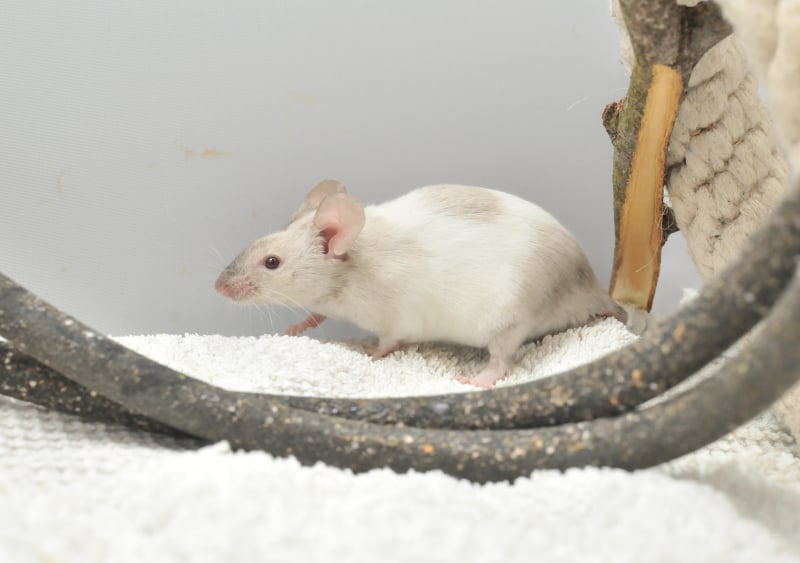
Tricolour – a mouse with patches of at least three colours over the body e.g. a splashed mouse with white markings. A tan mouse with white markings may or may not be referred to as tricolour depending on where you live.
However, many marked mice don’t fit into a neat description. If specific patterns of white and colour haven’t been selected for in breeding, then the mice often end up splodgy, with from just a few hairs of white, to just a few hairs of colour, and anything and everything in between.
Coat varieties
Pet mice don’t just vary in colour and markings – they can also have different types of fur.
Hairless
Hairless, “fuzzy” (US), Rex (Eur) mice – these mice are all on a sliding scale of missing all or some of their coat. Various genes cause this; some will never have hair, some will start with hair and then lose it as they grow, some will have patches, some no body hair but a few curly whiskers etc. There are lots of names for the differing appearances. The colour of their skin will depend on the genes they have for fur colour with paler colours being pink and darker colours being grey.
Hairless varieties can have some health concerns. Hairless mice are often smaller than average as they are constantly burning up calories to keep warm without furry insulation. The absence of eye lashes can also make them prone to eye infections. Those with tightly curled fuzzy fur can suffer skin irritation as it can be hard for the mouse to groom dust and dirt from between the hairs.
Astrex (Eur) and Rex/ Frizzie (US)
Astrex (Eur) and Rex/ Frizzie (US) mice have curly hair although they usually get less curly as they age. They can experience eye-infections in the same way as hairless mice if they have reduced or very curly eye lashes.
Both hairless and curly coated mice have curled whiskers. Like many animals, mice use their whiskers as a sensory organ, helping them assess their surroundings and find their way around. Missing or curly whiskers therefore raise the risk of sensory impairment.
Satin
Satin mice have fur that is very shiny or sparkly. The metallic effect is more striking on some colours; sometimes you may only be able to tell if a mouse is satin or not by their tummy hair. The effect is achieved by hairs which are hollow, which changes how the light bounces off the fur.
Longhair
Longhair mice, as the name implies, have longer hair. The coat can sometimes be slightly sparser, and tends to be soft and floaty. Bucks usually have longer hair than does, but both sexes look shaggy as they age.
Several of these coat types can happen at the same time e.g. curly satin longhair isn’t impossible. Although they don’t in themselves cause health problems, the more unusual features a coat has, the harder it can be to assess the condition of the fur (which relates to general health) and spot early warning signs of problems.
Shorthair
Shorthair is the standard coat fancy mice have. It’s a smooth glossy coat made of short straight hairs that lie flat to the body when all is well. If the mouse is angry or unwell they can fluff the coat up so it stands on end.
Standard coats shouldn’t be seen as boring – as well as making it easier for mice to express themselves and owners to spot health problems, many of the colours mice come in look more distinct in a standard coat too.
Does variety affect the health of mice?
Most of the genes involved in how a mouse looks aren’t linked to either physical or behavioural health. Sometimes certain colours can be thought of as having a certain temperament or health status, but usually that’s coincidence due to breeding for temperament or health in the line.
However, there are some instances where the genes that dictate appearance can also influence health. We’ve already talked about those relating to coat type above, but there are some issues with certain colours too.
The most important ones are red (red / ginger fur with black eyes) and fawn (red / ginger fur with pink eyes). The coat of these mice is the colour of the most reddish orange imaginable, and as well as being big in colour, they are big in size. Obese in fact. The gene that gives them their colour also makes them super-efficient at digesting food. To be healthy, they need a carefully managed and calorie restricted diet from a very young age.
Marked mice with lots of white (including black eyed whites, which are essentially marked mice with so much white there’s no colour) can suffer megacolon, a fatal condition where the intestines don’t move food along properly. It’s especially common where mice have been bred with no regard for health. Affected mice need to be humanely euthanised rather than being left to suffer a slow painful death. As with other species, marked mice without pigment on/near the ears can be deaf.
Tailless (Manx) mice either have no tail at all, or tail stubs. Some may even just have shorter than average tails. Being completely tailless can be very damaging to health as the developmental abnormality that causes it can affect their back-leg and intestine function. However, even mice with short tails can have problems. Mice use their tails to thermoregulate; they can expand and reduce blood vessel size in their tails to either increase the amount of heat loss (if they’re too hot) or minimise it (if they’re too cold). They also use their tails like a fifth limb; the reason mice are so great at balancing and climbing is because they use their tails both as an extra hold for grip, and as counterweights. And something you might not know is that mice sometimes use their tails to communicate with each other. So, having a stumpy or missing tail risks impairing their ability to regulate their body temperature, their agility and their communication.
So which variety of pet mice is best?
There’s no universal answer to that question. We recommend avoiding varieties with linked health problems, but once welfare has been considered, it comes down to what looks people prefer.
Where to find out more?
This article has only covered the most common varieties of mice found in the UK (where Beri is based). There are so many genes involved in the appearance of mice that there are hundreds of possible looks. Good websites to read more, and for clear photo examples are:
Photographer: Beri Instone. Photos are protected by copyright.



